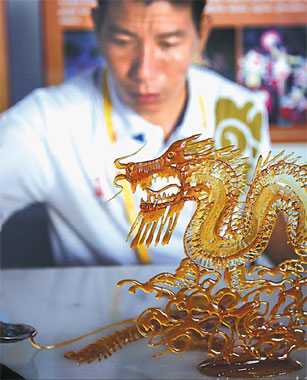Chongqing Hut
|
A sugar dragon made by sugar painting master Liu Guibin is displayed in the Chongqing Hut. File photo |
Wu Xiulan fills the inside of the hut with a powerful folk song.
The Sichuan boatwoman is the only female to have inherited the chuangjiang working song.
"I couldn't bring my voice into full play as I do when I work on the river because of the limited space," says the 66-year-old.
Yet, her strong voice still managed to command the attention of her audience. Draped in traditional indigo-print fabric and a red band, Wu, who was born into a boatman's family and is married to a porter, tells visitors about the life of boaters and porters living along the Yangtze River.
The complex and rhythmical songs are sung at various tributaries: mainstream, upstream and downstream. They reflect upon the innermost feelings of the boatmen and boatwoman and are recognized as a national intangible cultural heritage.
Apart from the folk song, a renowned Sichuan opera face-changing performance also went down well with visitors. Raising his hands and tossing his head, an actor uses a variety of opera masks to show a mix of emotions. The green, blue, red, yellow, brown, black and gold masks show everything from fear to tension, relaxation, desperation and outrage.
Visitors are also given a taste of edible sugar paintings made by master Liu Guibin. The thawed sugar is drawn on to cold stones, casting several auspicious patterns such as birds, fish and flowers. Inheriting its ideas and concepts from traditional shadow play and sculpting techniques, sugar paining is quite popular in the mountainous city nowadays.
(China Daily 08/23/2008 page15)















